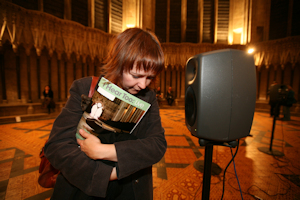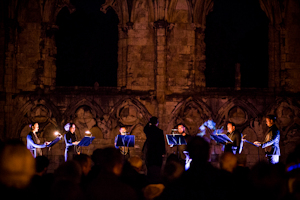
In 2009, the I Hear Too project (Murphy and Brereton 2012) set out to investigate how sound might be used to inform and transform our experience of heritage more generally, and one of the key aspects of this initiative was I Hear Too Live, where York Minster was used as an acoustic canvas by a series of sound artists to explore their own creative practice. York Minster is an iconic building within the centre of York – a place for worship, tourism, music or theatrical performance, but rarely a place to be enjoyed in terms of its own unique and dramatic sound environment. Seven artists and the Ebor Singers choir were commissioned to respond to the acoustics of York Minster in whatever way they felt appropriate. This resulted in a range of audio experiences – mixed media video and sound in the quire, spoken word in the Zouche Chapel, whispered voices over multiple loudspeakers in the Chapter House, laptop musicians in the Nave, interspaced with bespoke performances from the Ebor Singers (Figure 27). The audience were encouraged to sit, explore, walk, listen and enjoy as they felt comfortable, resulting in a unique and memorable experience for all involved.

This idea for a bespoke musical performance or event, specific to a given space, place and time resulted in I Hear Too Live being repeated, both in York Minster and then in 2012 at the Guildhall and Mansion House buildings, also in York. In this latter example, a new piece, Architexture I, was commissioned from composer Ambrose Field for the Ebor Singers, designed for the specific acoustics of the Guildhall. Composers and musicians have always created music and performances for specific locations, but in this case, auralisation methodology was, for the first time, used as part of the process. Acoustic measurement was used to obtain a set of room impulse responses from the Guildhall that Field analysed in terms of reverberation time and frequency content, yielding information that was then used to optimise the melodic, harmonic and rhythmic content of the vocal lines, resulting in 'precise and intricate connections between the musical material and the architecture of the venue', as stated by Field and quoted in Murphy and Brereton (2012).

This practice was developed further in 2015 for Architexture II (Field 2015), another collaboration between Field and the Ebor Singers (Figure 28). This piece sees the natural development of Field's exploration of auralisation methodology, compositional practice and the experience of acoustic heritage. The site chosen in this case, however, is a ruin and so acoustic measurement could not be used: St Mary's Abbey Church was closed and subsequently destroyed in 1539 as part of Henry VIII's Dissolution of the monasteries. The remaining ruins are now part of Museum Gardens, York, giving a dramatic backdrop to this multi-use public park, and are the starting point of a 3D computer model that has been developed and optimised over a number of studies (Oxnard and Murphy 2012) based on existing remains and additional third-party scholarship and evidence (e.g. Wilson and Mee 2009). The impulse responses obtained from the model were analysed and used by Field as part of the compositional process as before, but in this case there is no actual space available in which to hear the final work. Instead, interactive auralisation was used to render the sound of the reconstructed St Mary's Abbey Church as part of the actual performance. Based on the work of Laird et al. (2014) and in particular the virtual singing studio developed in Brereton et al. (2012), the members of the Ebor Singers wore headset microphones to capture their natural vocal performance, with the results rendered and spatialised in real-time via multiple channels of convolution processing using the impulse responses obtained from the 3D model of the reconstructed space. Architexture II took place within the ruins of St Mary's, with the Ebor Singers singing live and the final auralisation played back over multiple PA-speakers to an audience of several hundred people, demonstrating a powerful example of how acoustic heritage and audio creativity together can provide a unique perspective and experience of aspects of our past.
Internet Archaeology is an open access journal based in the Department of Archaeology, University of York. Except where otherwise noted, content from this work may be used under the terms of the Creative Commons Attribution 3.0 (CC BY) Unported licence, which permits unrestricted use, distribution, and reproduction in any medium, provided that attribution to the author(s), the title of the work, the Internet Archaeology journal and the relevant URL/DOI are given.
Terms and Conditions | Legal Statements | Privacy Policy | Cookies Policy | Citing Internet Archaeology
Internet Archaeology content is preserved for the long term with the Archaeology Data Service. Help sustain and support open access publication by donating to our Open Access Archaeology Fund.